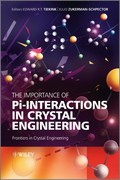The Importance of Pi-Interactions in Crystal Engineering
Frontiers in Crystal Engineering

2. Edition March 2012
392 Pages, Hardcover
Wiley & Sons Ltd
Short Description
Written by internationally recognized researchers, this book guides crystal engineers in the types, strengths, and nature of possible intermolecular interactions. The book covers topics ranging from the identification of interactions involving p-systems, their impact on molecular and crystal structure in both organic and metallorganic systems, and how these interactions might be exploited in the design of new materials. Ideal for those working in the crystallography, medicinal, and pharmaceutical sciences, this book also provides an essential overview of non-covalent interactions involving p-systems.
Written by internationally recognized researchers, this book guides crystal engineers in the types, strengths, and nature of possible intermolecular interactions. The book covers topics ranging from the identification of interactions involving p-systems, their impact on molecular and crystal structure in both organic and metallorganic systems, and how these interactions might be exploited in the design of new materials. Ideal for those working in the crystallography, medicinal, and pharmaceutical sciences, this book also provides an essential overview of non-covalent interactions involving p-systems.
List of Contributors xv
1 The CH/À Hydrogen Bond: Implication in Crystal Engineering 1
Motohiro Nishio, Yoji Umezawa, Hiroko Suezawa and Sei Tsuboyama
1.1 Introduction 1
1.2 Cooperative Effect of the CH/À Hydrogen Bond 7
1.3 CH/À Hydrogen Bonds in Supramolecular Chemistry 14
1.4 Crystallographic Database Analyses 25
1.5 Systematic CSD Analyses of the CH/À Hydrogen Bond 28
1.6 Summary and Outlook 31
2 New Aspects of Aromatic À. . . À and C-H . . . À Interactions in Crystal Engineering 41
Roger Bishop
2.1 Introduction 41
2.2 Three-Dimensional Aromatic Structures 44
2.3 Endo,Endo-Facial Dimers 46
2.4 Multiply Halogenated Heteroaromatic Molecules 49
2.5 Expansion of the Endo,Endo-Facial Dimer 56
2.6 (EF)6 Brick-Like Building Blocks 59
2.7 Other Novel Multiple Edge-Face Assemblies 64
2.8 Other Types of Aryl-Aryl Contacts 68
2.9 Conclusions 75
3 CH. . .À and À. . .À Interactions as Contributors to the Guest Binding in Reversible Inclusion and Encapsulation Complexes 79
Dr. Pablo Ballester and Dr. Shannon M. Biros
3.1 Introduction 79
3.2 Probing Aromatic-Aromatic (À-À) Interactions and CH-À Interactions with Solid-State Structures of Reversible Inclusion and Encapsulation Complexes 83
3.2.1 Inclusion Complexes 83
3.3 Summary and Outlook 104
4 A Rudimentary Method for Classification of À···À Packing Motifs for Aromatic Molecules 109
Leigh Loots and Leonard J. Barbour
4.1 Introduction 109
4.2 Theoretical Models 110
4.3 À···À Interactions 111
4.4 Structure Prediction and Comparisons 113
4.5 À···À Interactions in Heteroaromatic Molecules 113
4.6 À···À Interactions in Cocrystals 119
4.7 Summary 123
5 Conformational Flexibility and Selectivity in Host-Guest Systems 125
Nikoletta B. Bathori and Luigi R. Nassimbeni
5.1 Introduction 125
5.2 Selectivity 129
5.3 Concluding Remarks 139
6 Organic À-Radicals in the Solid-State: from Localised to Delocalised Ã-Bonding 143
Marc Fourmigue
6.1 Introduction 143
6.2 Molecules for À-Radical Formation 144
6.3 Dimers of Radicals versus Radical Dimers (Pimers) 149
6.4 Solid-State Magnetic and Conducting Properties 154
6.5 Conclusions 159
7 Arene-Perfluoroarene Interactions in Coordination Architectures 163
Akiko Hori
7.1 Introduction 163
7.2 Background 165
7.3 Guest Recognition by Coordination Networks 169
7.4 Fluorinated Coordination Complexes 172
7.5 Cocrystals of Coordination Complexes 179
7.6 Self-Assembly in Solution 181
7.7 Conclusions 182
8 Halogen. . .À Interactions as Important Contributors to Binding Affinity in Medicinal Chemistry 187
Hans Matter, Marc Nazare, and Stefan Gussregen
8.1 Introduction 187
8.2 General Aspects of Halogen Atoms in Medicinal Chemistry 189
8.3 Fluorine: a Unique Halogen Atom 190
8.4 Interactions of Higher Halogen Atoms 196
8.5 Interactions of Higher Halogen Atoms to Aromatic Rings 204
8.6 Conclusions 226
9 Fuzzy Electron-Density Fragments as Building Blocks in Crystal-Engineering Design 233
Paul G. Mezey
9.1 Introduction 233
9.2 A Brief Review of a Fuzzy Electron-Density Fragmentation Scheme Suitable for Molecular Design 235
9.3 The Low-Density "Glue" Range of Globular Macromolecules, Functional Groups, and the Role of À-Interactions in Fuzzy Fragment Selection 238
9.4 Summary 239
10 Noncovalent Interactions of À-systems in Crystal Structures of Transition-Metal Complexes 243
Goran V. Janjic and Snezana D. Zaric
10.1 Introduction 243
10.2 Interactions with Organic À-Systems 244
10.3 Interactions with À-Systems of Chelate Rings 254
11 Intermolecular C-H * * * À(Chelate) Interactions - Prevalence in the Crystal Structures of Metal 1,1-Dithiolates 275
Julio Zukerman-Schpector and Edward R.T. Tiekink
11.1 Introduction 275
11.2 Methodology and Preliminary Survey 277
11.3 Supramolecular Architectures Based on C-H* * ·À Interactions 280
11.4 Discussion and Conclusions 295
12 Supramolecular Aggregation Patterns and Stereochemical Consequences of Tellurium(Lone Pair)* * ·À(Aryl) Interactions 301
Ionel Haiduc, Edward R.T. Tiekink and Julio Zukerman-Schpector
12.1 Introduction 301
12.2 Methodology 302
12.3 Results 303
12.4 The Influence of Te(Lone Pair)* * ·À(Aryl) Synthons Upon Coordination Geometry 318
12.5 Summary and Conclusions 319
13 Supramolecular Assembly of Silver(I) Complexes with Argentophilic and Silver. . .Carbon Interactions 323
Thomas C. W. Mak, Liang Zhao and Xiao-Li Zhao
13.1 Introduction 323
13.2 Silver Double/Multiple Salts Containing Ag2C2 326
13.3 Supramolecular Assembly of Silver(I) Double/Triple Salts with Potentially Exo-Bidentate Ligands 332
13.4 Silver(I) Multiple Salts of 1,3-Butadiynediide (C4²-) 337
13.5 Supramolecular Assembly with Silver tert-Butylethynide 338
13.6 Double/Multiple Salts of Silver Arylethynides 342
13.7 Assembly of Silver-Heteroaromatic Ethynide Supramolecular Synthons R-C=C Agn (n = 4, 5) (R = Thienyl, Pyridyl, Pyrazinyl, Pyrimidyl) 346
13.8 Assembly of Silver-Ethynide Supramolecular Synthon Assisted by Silver. . .Aromatic Interaction 350
13.9 Assembly of Silver-Ethynide Supramolecular Synthon Assisted by Intermolecular Silver. . .Halogen Interaction 352
13.10 Coordination Networks Constructed of Multinuclear C2@Agn Aggregates and Polyoxometalate Species 353
13.11 Supramolecular Assembly of Large Silver-Ethynide Clusters 355
13.12 Conclusion and Outlook 363
Acknowledgments 363
References 364
Index 367


